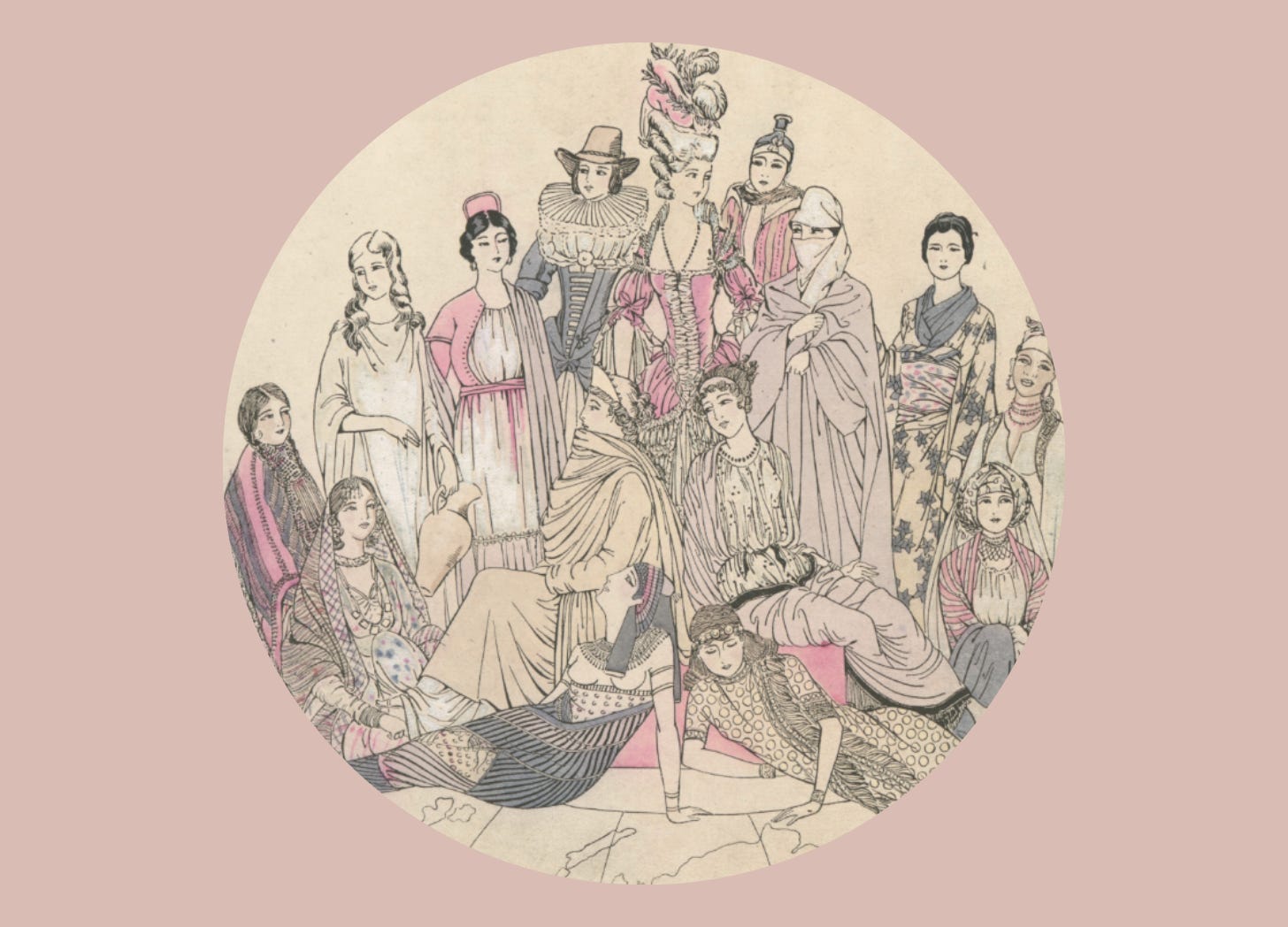Published in 1926, The history of the feminine costume of the world is an equally fascinating and useful resource in term of fashion history and costume, but it is also a curious study in the way the western imperialist gaze perceived non-western women, as well as the understanding of their clothing and culture. It is a document that opens a window into the past, and the historical understanding of fashion, clothing and textiles, and of other cultures. It is a way to discern the ways imperialism seeped through our understanding of fashion history, and the thread of colonialism in the fabric of academia. This document presents at the very least an overview of the clothing styles and the fashions of each region and culture. Written by Paul Louis de Giaferri and illustrated by several artists only identified through their signatures, this encyclopedia showcases an array of beautiful clothes from various cultures and societies across the world. The art that is utilized for this volume is very precise, with crisp lines, reminiscent of the art style in vogue in illustration during this decade. The way this encyclopedia has been organized is reminiscent of fashion plates that have been in use since the 17th and 18th century, and were the main mode of disseminating the new fashions and modes in clothing before photography and mass media. This book is a work of art in itself, with beautifully composed illustrations and examples of various outfits and costumes that exists throughout cultures. It is available in the digital collection of the New York Public Library as a book and it’s genuinely fascinating to digitally leaf through.
This document is a very useful reminder of how the discipline of fashion history was in the 1920s, and the body of knowledge that was available to them at that time, it is a time capsule of fashion history of sorts. Fashion history is a discipline that has been ever evolving and finally taken seriously, notably in the past 30 years, as the discipline has been more inclusive and diverse, as more and more people have been writing, researching and bringing new information to our understanding of fashion history. Especially in areas of the world where there hasn’t been as many studies on fashion history, because we have to remember that often that history had been forcibly erased, and the culture and craftsmanship of several regions was devalued or destroyed because of imperialism. After all, the erasure and replacement of indigenous garment by the colonial garb is one of the tenet of assimilation and folding indigeneity into the empire. There has had to be a concerted effort to bring back so much of knowledge that has been lost or discarded in the past years, and revive techniques and crafts that had been erased. And while the study of fashion and art history has definitely come a long way since the 1920s, there is still a long way to go still in effectively decolonizing the practice.
This artefact is thus in a weird intersection when it comes to non-western fashion history, because while I do feel like there is a sincere desire to document the garment and costumes of their cultures, to compile the knowledge of the wide scope of feminine-wear across the world in one easily accessible resource, it still cannot escape its biases, and the colonial and definitely racist outlook that it projects on non-white people; the section on "primitive races" (ew) is simply a section on ALL of the indigenous cultures and Africa at the same time, and so it flattens all of them in one category, ignoring both their dignity and all of the cultural richness that each of those regional culture possesses, and ignoring the different subtleties and nuances that they offer in their attire. Meanwhile, when it comes to Europe, every single region is richly illustrated and detailed, from northern, central, southern Europe, to France and the United Kingdom, taking the time to truly dig into every single regional and intricate differences of the western garment, which is important, because there is a lot of complexity in dress and costume, and I do like seeing it be treated seriously and earnestly, however, this attention to details is not given to non-western cultures and clothing, giving a few examples of the fashions of that culture, but comparatively, nothing that feels like it would truly give a solid overview and understanding of the clothing that people wear.
I do still think this book is a somewhat useful fashion history resource, it is an even more useful resource when it comes to dissecting the history of fashion history, where it stood a hundred years ago, as well as the colonial understanding of the other. After all, for certain cultures, these kinds of documents are some of the few resources that we have. It's worth a look, the illustrations are very pretty even though i'd be wary of the orientalism and fetishizing gaze that is very pervasive in the art, I think it can still be a good starting point for research in the historiography of fashion history.





